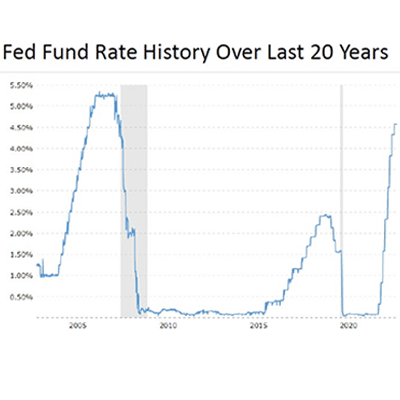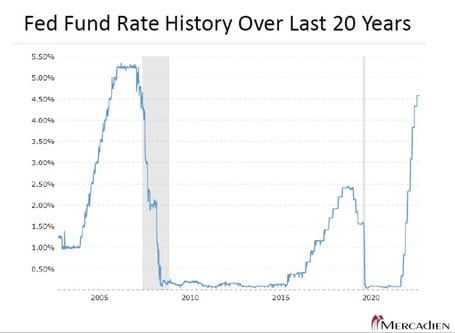Knowledge and Insights
10 Ways to Protect Your Institution During Uncertain Times

We’ve all read the shocking news of recent financial institution failures. We’re also well aware of quickly rising interest rates and volatility in the market. Regulatory scrutiny is coming, and your institution’s asset/liability and liquidity management (ALLM) processes will fall under more intense review. Are you ready for that? Let’s start by looking at how we got where we are today, then we’ll get into ways you can protect your institution.
CURRENT STATE OF THE BANKING INDUSTRY – HOW DID WE GET HERE?

The graph above displays the Fed Fund Rate History over the last 20 years. As you can see, starting in 2003, we were at historical lows that eventually went even lower to near zero. Rates increased over a few years and then the recession of 2008-2009 led to very sudden declines in rates that remained for several years. The Fed started to increase the rate slowly over time, which then took another nosedive due to the COVID-19 pandemic, where it stayed at near zero until the last 12 months.
While the current shock of 4.75% is considered a large shock to rates, when looking at the Fed Fund Rate History, this is not atypical. However, prior upward shocks in the past 20 years have not been as severe and quick as what we are experiencing today, with the last time being in 1989.
So why is this shock so devastating to liquidity, and financial institutions compared to shocks of the past? It can be attributed to two main factors:
- Ease of moving money & opening accounts – today, anyone can easily go onto their phone, open a new account and transfer all of their money with a few clicks of a button. In the past, opening and closing accounts and transferring money was not as easy or accessible.
- Social media – Warren Buffet once said, “It takes 20 years to build a reputation and five minutes to ruin it”. With social media, a company’s reputation can be ruined in an instant. Case in point – Silicon Valley Bank. In the past, when we experienced shocks, social media was nowhere near as popular as it is today.
HOW YOU CAN PROTECT YOUR INSTITUTION
There are numerous ways you can protect your institution from increasing regulatory scrutiny given the current environment, and potentially prevent what happened to Silicon Valley Bank and Signature Bank from happening to your institution.
- Review your social media policies and make improvements if needed. Your institution’s social media policy is extremely important. You should make sure someone is monitoring social media for posts made about your organization and responding in a timely manner so you can stay in front of any negative press.
- Deploy customer outreach. With everything going on in the banking industry, you are likely getting an increasing number of inquiries and questions from your customers. Your institution should (if they haven’t already) distribute communications to customers letting them know they are in safe hands.
- Keep uninsured deposits at a safe level. One of the contributing factors to the downfall of Silicon Valley Bank was their number of uninsured deposits, which was around 94% of their total deposits. This is an extremely high rate. According to our research, we found that around 40% is typical for community and regional banks.
- Strengthen your three lines of defense model. The first line of defense lies with the Accounting and Treasury Department, who should be maintaining and using Liquidity and Asset/Liability models for day-to-day activities. The second line, Risk Management, should be enforcing liquidity stress test limits and ensuring liquidity reports include accurate, timely and relevant information on risk exposure. They should also challenge liquidity stress testing scenarios and assumptions to ensure they are adequate and used properly in the stress testing scenarios. For the third line of defense, Internal Audit, you should audit your Asset/Liability and Liquidity process and make any necessary improvements. Additionally, you should perform model validations either in-house or through a third-party provider to aid in risk management.
- Perform liquidity stress testing scenarios and testing assumptions over different periods of time. You should be running liquidity stress testing scenarios and testing assumptions over a 3-, 6- and 12-month period. For example, we’ve seen deposit runoff at 2%, 5%, 10%, drawdown loan commitments at 25%, 50%, 100%, borrowing capacity reductions at 10%, 30%, 100%, over the 3-, 6- and 12-month period. We’ve also seen borrowing collateral haircuts and prohibition on brokered deposits. When developing scenarios, you should look at the unique risk within your institution and take into account your institution’s history. Consider low probability high impact scenarios, such as negative reputation risk, which can cause significant deposit runoff in a single day.
- Increase frequency of liquidity stress testing. If you are currently stress testing liquidity quarterly, consider moving it up monthly. Think about shocking daily or weekly. What can your institution absorb on a daily basis? For example, if you put in a simple scenario such as losing 50% of uninsured deposits in a day, or all lines of credit get extended in one day, would your organization still be okay? At the rate customers can move money today, it’s imperative to shorten these time horizons to account for any scenario.
- Ensure cash flow projections are adequate and make enhancements if needed. You should review and look at your cash flow projections regularly, ensuring all data is populated properly and that the projections are in line with your strategic plan. It’s not just a check the box function, it’s the lifeline of your organization, so you need to make sure the information is accurate and reliable.
- Evaluate your access to borrowing lines. Some banks may have access to an FHLB or other banks for borrowing. Now there’s the Fed’s Bank Term Funding Program, created to provide additional funding to eligible depository institutions to help assure banks have the ability to meet the needs of all their depositors. Also remember to test the impact on restrictions that may be applicable on those lines.
- Document, document, document. Document any changes you have made to your ALLM and risk management processes in light of the recent bank closures and have that documentation ready to be submitted to your regulator. They may have already asked your institution for this information.
- Engage a third-party service provider to assist with risk management. We all know there are many different types of risks financial institutions need to account for. With the current rising interest rates and market volatility, nothing can fall through the cracks - you need to ensure your asset/liability and liquidity management processes are strong enough to manage your institution through sudden liquidity events as well as withstand scrutiny from regulators. Consider engaging a third-party expert in asset/liability and liquidity management, like our team at Mercadien, to strengthen your ALLM processes and protect your institution. Our team can review your financial institution’s asset/liability and liquidity management function to help ensure it is in compliance with regulatory requirements, and your institution is not at an unacceptable level of risk. Additionally, we can perform model validations to verify your models are performing as expected and offer recommendations for improvement.
OUR TEAM OF EXPERTS IS HERE FOR YOU - CONTACT US TODAY
Mercadien’s Financial Institutions Services Group provides BSA, internal audit, validation, compliance, risk management and consulting services to financial institutions across the nation. Our team has extensive, in-depth knowledge of the banking industry and uses that knowledge to provide recommendations and solutions that you can rely on. To learn more about how we can assist your institution, please contact me at szerilli@mercadien.com.
